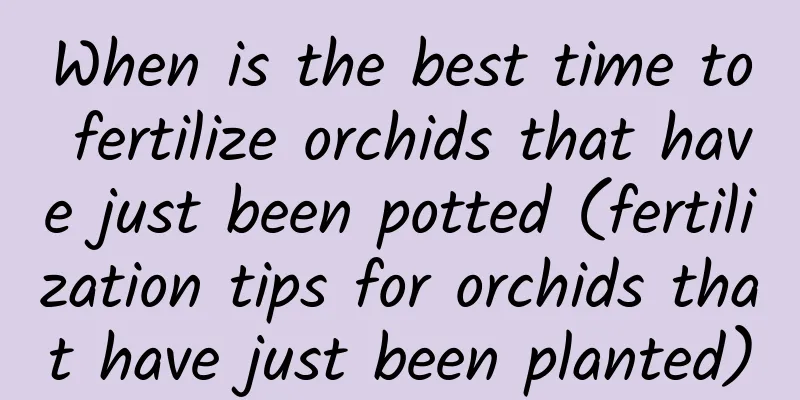When is the best time to fertilize orchids that have just been potted (fertilization tips for orchids that have just been planted)

|
In fact, for orchids that have just been potted, it is best not to apply fertilizer before they have adapted to the pot . Because probiotics have not yet formed around the roots of newly potted orchids, they cannot absorb and utilize the elements in the planting material and external fertilizers. Applying fertilizer will not only be detrimental to the growth of orchids, but will cause fertilizer damage. Generally, there is no fixed time limit for when to fertilize a newly potted orchid. It depends on its acclimatization . Fertilizer can be applied after it has completely acclimatized. If the orchid has begun to acclimate, you should control the timing according to the needs of the orchid's growth and development stage, as well as temperature, light and seasonal changes . According to the nature and efficacy of fertilizers and the original fertility of the planting materials, we should apply light fertilizers, at the right time and in the right amount. We should pay attention to the following three points: 1) Apply base fertilizerBasal fertilizer is the fertilizer applied to the bottom of the orchid pot before potting. It is generally a slow-release fertilizer. Its purpose is to provide orchids with use throughout the growing period. For example, decomposed sheep dung balls, bone meal, hoof horns or poultry feathers can be used as basal fertilizers, which can be placed directly on the bottom of the orchid potting material when the orchid is potted. Orchids can be fertilized with basal fertilizers, and less or no topdressing can be applied in the later stage. Since new planting materials need to be replaced every 1 to 2 years, even if chemical fertilizers are used as top dressing after the plants have adapted to the pot, it will not affect the quality of the planting materials. 2) Apply topdressingBasal fertilizer provides nutrition for orchids throughout the year. Its effect is slow. Generally, when using granular planting materials to grow orchids, adding a little basal fertilizer is better. If the planting material is fertile, no basal fertilizer is needed. However, during the special period of orchid reproductive growth, more nutrients are needed, and topdressing is needed at this time. Topdressing usually uses thin liquid fertilizer, such as Huaduoduo No. 2 water-soluble fertilizer, which is applied every 7 to 10 days, and 1 to 2 times a month is appropriate. 3) Foliar fertilizationFoliar fertilization is also called foliar fertilization. It is to dilute the fertilizer solution according to the proportion and spray it on the front and back of the orchid leaves to make up for the deficiency of root fertilization. Foliar fertilizer takes effect quickly and requires little usage, and can enhance the disease resistance of orchids, but foliar fertilizer can never replace root fertilizer. Only inorganic fertilizers such as urea, potassium dihydrogen phosphate, and superphosphate that are easily soluble in water can be used in the morning and evening when the temperature is low on sunny days. The appropriate concentration is 0.1% to 0.2%. Too light fertilizer has low efficiency, too concentrated fertilizer is difficult to absorb, and it is very easy to hurt the seedlings. In short, it is best not to fertilize orchids that have just been potted. If the orchid has already adapted to the pot, it is necessary to apply fertilizer lightly according to the needs of the orchid's growth and development stage, combined with weather conditions and the original fertility of the planting material, and adapt to local conditions . Don't rush and blindly fertilize the orchid before it has adapted to the pot. Not only will the orchid not be able to absorb and utilize the fertilizer, but it will also cause fertilizer damage, which is not worth the loss! |
<<: How to grow colorful peppers in pots (tips on how to grow colorful peppers indoors)
>>: Cultivation method of potted lotus (methods and steps for growing lotus at home)
Recommend
Cherry pictures, when are cherries ripe
1. Ripe Season Cherries generally ripen in summer...
Are daisies poisonous?
Are daisies poisonous? I can tell you very confid...
Cultivation methods and precautions of Anemone
Anemone is a relatively easy plant to grow. It li...
How to water the bamboo palm? How often should I water it?
1. Watering method The amount of water required b...
How to grow shell flowers
1. Maintenance methods 1. Temperature: Shell flow...
Should I use a large or small pot for strawberries?
Should I use a large or small pot for strawberrie...
Can the double-line arrowroot be hydroponically cultivated? Is hydroponics or soil cultivation better?
Can the double-line arrowroot be hydroponically c...
Plants that easily outgrow their pots, maybe you have one at home
Sunflower Portulacaceae Portulaca Key points for ...
Can Lactarius pine be cultivated artificially (cultivation technology and yield)
1. Planting technology 1. Choose summer and autum...
How to deal with daffodils after they bloom
Flower treatment Daffodils are actually one of th...
Why does Clivia bloom in spring?
1. Lighting In spring, everything seems a little ...
Which month is the best to plant coriander?
Coriander , also known as cilantro in some places...
Kumquat Growth Environmental Conditions and Characteristics
Kumquat Growth Environmental Conditions and Requi...
What is the function of green radish? Can it absorb formaldehyde?
1. Function 1. Ornamental decoration: The leaves ...
The best season to prune bougainvillea
There are many varieties of bougainvillea , and t...









